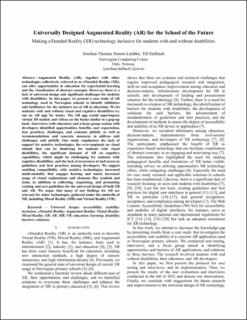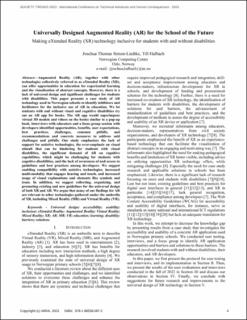| dc.description.abstract | Augmented Reality (AR), together with other technologies collectively referred to as eXtended Reality (XR), can offer opportunities in education for experiential learning and the visualization of abstract concepts. However, there is a lack of universal design and significant challenges for students with disabilities. This paper presents a case study of AR technology used in Norwegian schools to identify inhibitors and facilitators for the inclusive use of AR in education. We let students with and without visual and cognitive disabilities try out an AR app for books. The AR app would superimpose virtual 3D models and videos on the books similar to a pop-up book. Interviews with educators and a focus group session with developers identified opportunities, benefits, user expectations, best practices, challenges, common pitfalls, and recommendations and concrete measures to address said challenges and pitfalls. Our study emphasizes the lack of support for assistive technologies, the over-emphasis on visual stimuli that can be hindering for students with visual disabilities, the significant demand of AR on cognitive capabilities, which might be challenging for students with cognitive disabilities, and the lack of awareness of and access to guidelines and best practices among developers. We suggest enabling compatibility with assistive technologies, increased multi-modality that engages hearing and touch, and increased usage of visual explanations and elements like symbols and icons. In addition, we suggest collecting, organizing, and promoting existing and new guidelines for the universal design of both XR and AR. We argue that many of our findings for AR are relevant to other technologies gathered under the umbrella of XR, including Mixed Reality (MR) and Virtual Reality (VR). | |


